The loading screen is always the same in Assassin’s Creed. Your character stands, clad in the robes of his people, armed to the teeth and surrounded by empty space. A desaturated digital landscape fades into the distance and out of sight. You press the thumbstick forward, and he begins to jog. What’s left to do but run? And so you run.
I shudder to think how many cumulative hours I’ve spent trapped in Assassin’s Creed loading screens, running. Six? Eight? Half a day, perhaps, staring at a screen, watching a man trapped in a digital construct within a digital construct, sprinting endlessly and getting nowhere.
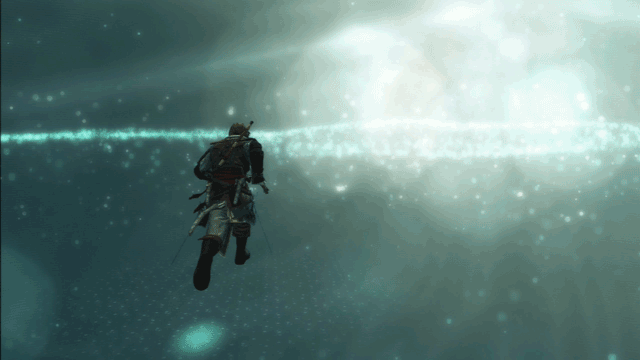
That loading sequence functions as both recurring feature and apt metaphor for the Assassin’s Creed series. Each game is a sprawling digital contraption that sends me running in all directions but often leaves me wondering whether I’m actually getting anywhere.
At their best, Assassin’s Creed games provide a wonderful way to occupy one’s time. They offer an enticing brand of historical tourism: Visit exotic lands in faraway places; climb to the tops of the highest national monuments; meet interesting historical figures, and kill them.
Assassin’s Creed IV: Black Flag, more than any previous Creed game, arrives at a crossroads between the series’ best traits and its worst habits. It is a vast game, an ocean-sized pirate’s chalice that stands empty and asks you to fill it, drop by drop, with your time and attention. It is if not the best pirate simulator I’ve ever played, certainly the most aesthetically pleasing.
But just as often as I’d find myself gleefully sailing the ocean blue, I’d be churning through the same menial Assassin’s Creed tasks I’ve churned through dozens of times before. Where lies the heart of this series? After six years and seven games, are we any closer to something resembling a destination? And is that destination — and the volumes of ongoing lore and backstory supporting it — even necessary, or could this game have simply been about pirates?
Assassin’s Creed itself sometimes feels trapped in those loading screens, unsure where it’s running or why.
Black Flag tells the story of Edward Kenway, a (sexy) 18th century privateer who sailed the Caribbean and (sexily) adventured through the West Indies. This is Creed game as pure historical fantasy. Call it Hot Pirate Simulator 2013.
Right from the outset, Black Flag appears to have studiously learned from the many failings of its predecessor, 2012’s Assassin’s Creed III. That game began with a lengthy prologue in which you controlled the eventual protagonist’s father Haytham Kenway. On and on it dragged, a tiresome setup to a twist that hardly felt worth the wait. By contrast, in Black Flag you’ll be sailing a ship within minutes and engaging in full-on piracy within the first couple of hours. Black Flag‘s Edward Kenway may be the eventual father of III‘s prologue-dragger Haytham, but the early goings of Edward’s story do not, blessedly, concern themselves with backstory or lineage.
The game starts by throwing us into Kenway’s boots as he pilots an ill-fated pirating vessel before, in short order, setting him up to kill a treacherous member of the West Indies Chapter of the Assassin’s Guild, Local 104. Ever the rogue, Edward dons his victim’s robes and decides to take on a delivery job the former Assassin died while undertaking, assuming the man’s identity in order to get paid. Things do not go according to plan, and so begins Edward’s long and winding road from rapscallionhood to brotherhood.
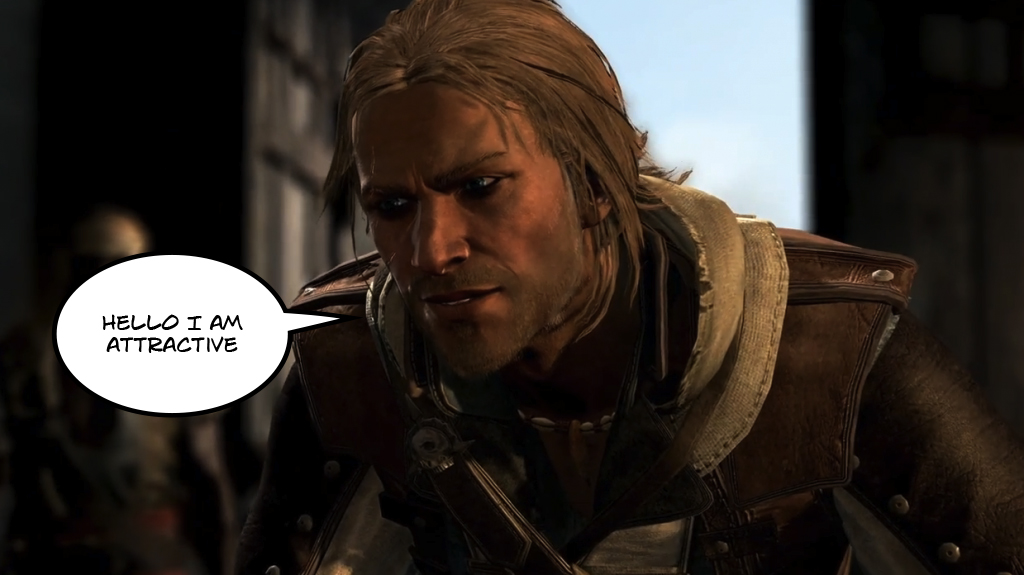
Edward’s story is a mess, but it’s a mess that’s charming just often enough to offset the clumsiness. He’s the series’ most reluctant subscriber to the Assassins’ cause and clan — he begins the game wearing the iconic robes out of convenience, and it takes him a good dozen hours to begin even grudgingly helping the Assassins in their ongoing battle against the power-hungry Templars.
The story, credited to Darby McDevitt, Mustapha Mahrach and Jean Guesdon, often feels like the kind of patchwork you’d expect to find holding together a game with this many moving parts. Scattered or no, it does have its moments. Blackbeard the pirate — who, full (awesome) disclosure, is a distant relative of mine — steals a few scenes as his raging inner demons boil to the surface. I enjoyed the odd overheard banter, like a couple of guards discussing how, when you think about it, “smuggler” is a really weird word. And while history dictates that the scurvy dogs with whom Edward runs are mostly men, women don’t get entirely overlooked — legendary ladies of the sea Anne Bonney and Mary Read break up the sausage-fest from time to time, always in welcome ways.
Things do start to fall apart toward the end, when, as tends to happen in these games, I found myself speaking with, chasing after and assassinating a series of enemies and allies whose names, allegiances and plot-importance I couldn’t keep straight. Edward’s character arc moseys about for the game’s first couple dozen hours, then sprints for the finish line. His dénouement felt substantially rushed, though the finale was still well enough executed to make me think fondly on characters I’d rarely cared about in the moment.
On the other side of time lies Black Flag‘s present-day story, another familiar conceit in the Creed franchise. The games are set up as two-pronged affairs, with a character in the present using a souped-up VR machine to travel into the ancestral DNA of the descendants of the game’s historical main characters.
Thanks to the events at the end of Assassin’s Creed III, Black Flag necessarily moves players from the point-of-view of the series’ previous present-day protagonist Desmond Miles to a silent first-person-perspective researcher working at a game development studio. (“Write what you know,” as they say.)
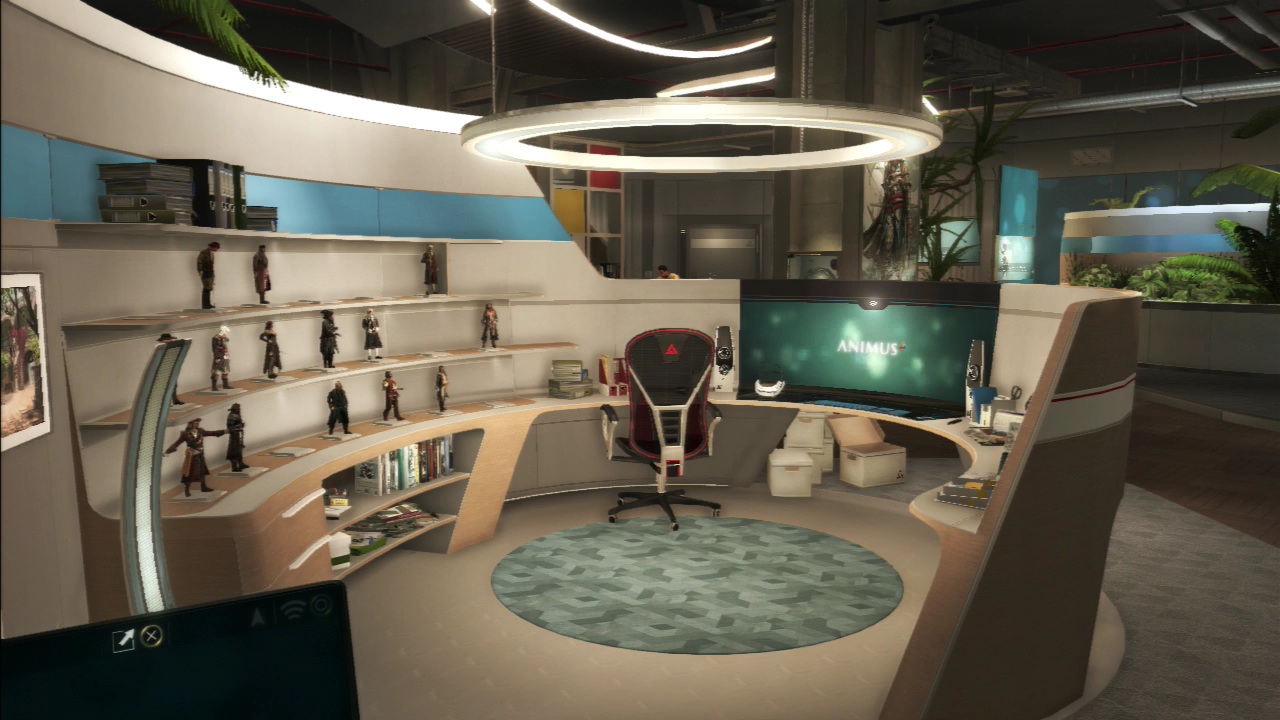
Ah, but it’s not just any video game studio… it’s an evil video game studio run by Abstergo, the corporate face of the villainous modern-day Templars. This obvious bit of meta humour — Abstergo Entertainment is located in Montreal, just like Black Flag‘s primary developer Ubisoft Montreal — is sometimes cute, but too often cutesy. Oh, how I grimaced as a character pitched me a game trailer much like the one Ubisoft actually premiered just before E3 this year. I spend too much time thinking about game development as it is, Ubisoft. I just want to pretend I’m a pirate for a while.
The lore-drops and revelations in the present-day will likely disappoint those who had been hoping to see some larger reveals in the wake of the near-apocalyptic culmination of Assassin’s Creed III. A couple of familiar faces turn up, but most of your time will be spent wandering around a game-development studio, breaking into your co-workers’ computers via hacking minigames that range from fun to frustrating to Frogger.
I’ve always had a fondness for Assassin’s Creed‘s convoluted present-day stuff, though I do acknowledge, as John Teti put it in his review of Assassin’s Creed III, that “the series’ techno-spiritual premise is just the flavorless saltine on which the peanut butter of old-timey assassination rests.” By and large, the present-day stuff feels more toned-down and optional in Black Flag, which feels like a step in the right direction.
While past games tasked Desmond with complicated platforming challenges and even the odd bit of combat, Black Flag simply has you checking out your co-workers’ desks and uncovering collectables if you so desire. As each of the few obligatory 10-minute exposition-breaks draws to an end, your kindly lady Abstergo handler usually hustles you back to your machine for more swashbuckling. Would you kindly climb back into the VR machine and resume your excellent pirate adventure? Why, I’d be happy to!
I found myself excited to return to the Caribbean because, well, the game is a great deal of fun to play. Black Flag is the most mechanically assured, sturdily designed game in the series. Everything works in concert much more harmoniously than it has in past games, particularly the rough-around-the-edges-and-middle Assassin’s Creed III. Inventory management, aiming, sneaking and sword-fighting all feel more of a piece than they yet have. And two of the series’ primary gameplay tentpoles — rooftop parkour and stealth — work far better here than they have in the past, largely because of more considered, well-executed level design.
Black Flag is the most mechanically assured, sturdily designed game in the series.
There are three major cities in Black Flag, each one considerably smaller than any of the previous games’, but each has been well-designed for rooftop acrobatics. Many of the same people who designed Black Flag worked on the fourth game in the series, Revelations, whose sprawling setting of Constantinople was easily the series’ most aesthetically pleasing, well-designed city. Black Flag‘s cities Havana, Kingston and to a lesser extent Nassau are all essentially skate-parks designed for leaping, scaling, swinging and climbing. At any moment, a number of easy-to-read “paths” extend in multiple directions, and traversing from one side of a city to another is often a great deal of fun both to do and to watch.
Black Flag carries over AC III protagonist Connor’s expanded, refined move-set — Edward will deftly hop from rooftop to treetop and back, spurred onward by the right trigger while never jumping from a great height unless you specifically tell him to. “Creed games have never controlled much better than a mostly-trained dog,” observed my boss Stephen last year, and that holds true in Black Flag. Edward will still run up the wall when you wanted him to run through a door. It’ll happen often, and it remains annoying. That said, Edward is the most well-behaved dog the series has yet offered, largely because III‘s improved controls are finally given levels designed to take advantage of them.
The strong level design is even more noticeable (and welcome) during stealth missions, of which there are dozens. Black Flag‘s sneaking is head and shoulders above the previous games in the series. Granted, that’s not a particularly high bar to clear, given the often lousy stealth in past Creed games. But Black Flag often feels like seven-tenths of a bona fide stealth game, which I mean as a compliment. I spent many hours merrily striking from the shadows, tagging and tracking enemies, and clearing out enemy compounds without raising any alarms. I found repeated, often thrilling success while taking on the game’s stiffest stealth challenges, something I can’t claim for any previous Creed game.
Watch a demonstration of the improved stealth here:
Despite those improvements, Black Flag leans on the series’ bad mission-design habits with a frustrating frequency. There are not, thankfully, any chase sequences as terrible as last year’s Razzie-worthy pursuit of Charles Lee. But there are still far too many follow/eavesdrop missions, better known as the barrel-bottom of Assassin’s Creed mission-types.
“Follow these guys,” the game tells me, for the fourth time in an hour. And so I follow the guys, keeping out of sight, until they arrive at a set point. “Eavesdrop on the conversation,” the game then tells me, projecting around them a glowing radius within which I must stay. The guys begin walking again. How many times have I performed this task in an Assassin’s Creed game, I ask myself as I struggle to keep up. How many times have I failed, only to repeat the process, listening to the same conversation over and over again? How many more of these mini-Hells must I endure before Ubisoft finally drops this tired, terrible, maddening task from their games?
And yet mere minutes later I’m at the helm of Edward’s ship the Jackdaw, dolphins leaping off of the bow, my hand on the wheel and my eyes on the horizon. Whatever purchase it may find and lose on land, Black Flag is at its best on the open water. Edward bellows orders to his crew, egging them onward through seas both stormy and calm. The game’s distinctive nautical beauty can be supremely evocative: as you peer through your spyglass into the distance, a flash of lightning illuminates the sails of a deadly Man of War, looming on the horizon. It’s coming for you.
Special recognition to series art director Raphael Lacoste and his team, who have managed to consistently capture the beautiful, purple-black mystery of the best pirate fiction. Black Flag looks less like a recreation of the 18th century West Indies and more like a dreamy, fantasy version of them. I’ve long thought of Lucasarts’ classic 90s adventure game The Secret of Monkey Island as the most beautiful pirate game I’ve ever played — the stars up above and the sand below, orange windows shining against the deep blue night, palm trees shifting in the breeze:
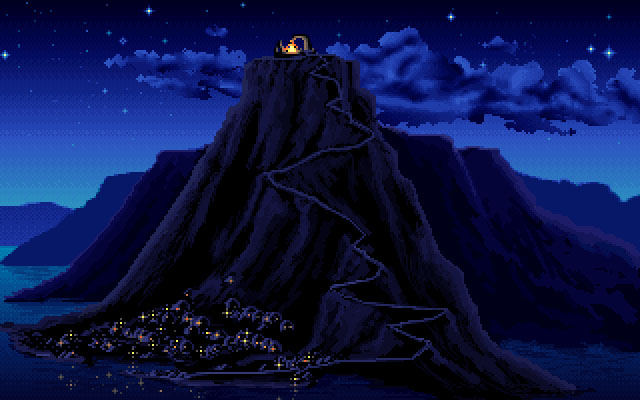
Black Flag regularly captures that look, albeit with a shade higher fidelity:
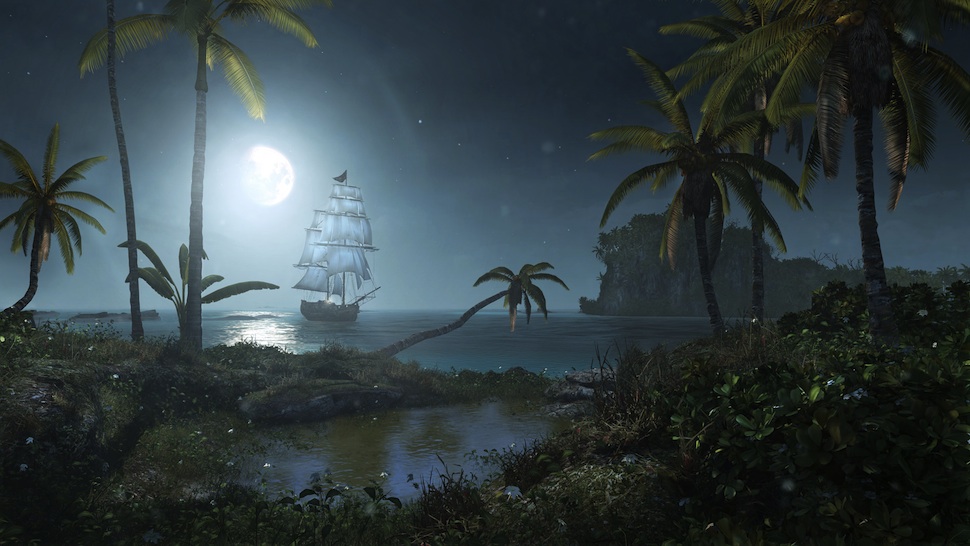
It’s a marvellous-looking game, on both current-generation systems (I reviewed the PS3 version) and on next-gen consoles. I spent an afternoon at Ubisoft HQ playing the PS4 version, and will have more thoughts about that version on Kotaku very soon. Briefly: This video isn’t misleading, and while it’s the same game either way, it does look awfully nice on PS4, as it likely will on Xbox One and on PC, my platform of choice for past Creed games.
Whenever Edward walks to the wheel of the Jackdaw, his crew lets out a rousing cheer. I love it when this happens. I’m happy to be back too, me hearties! The jargon he and his crew toss around — “Loose the tops and royals!” “Trim the yards off the wind!” — is drawn from a seemingly endless reserve of recorded dialogue, and has rarely failed to put a smile on my face. On sunny days, as the Jackdaw rides a calm breeze, a sailor may lead the crew in any of a number of period-appropriate sea shanties. These songs may be my favourite of Black Flag‘s many small touches.
Ship-to-ship combat is just as enjoyable as nautical exploration, if not more so. The cannon-aiming systems introduced in Assassin’s Creed III have all been significantly refined and smoothed out here — when it comes time to take on an enemy ship, the Jackdaw converts into a multi-pronged death-machine somewhat like an aquatic B-17 Flying Fortress; the Memphis Belle of the seven seas. Bryan Tyler’s rousing musical score — a mandolin/fiddle pastiche of Hans Zimmer’s Pirates of the Caribbean theme — kicks in, and the mortar rounds and cannonballs start to fly.
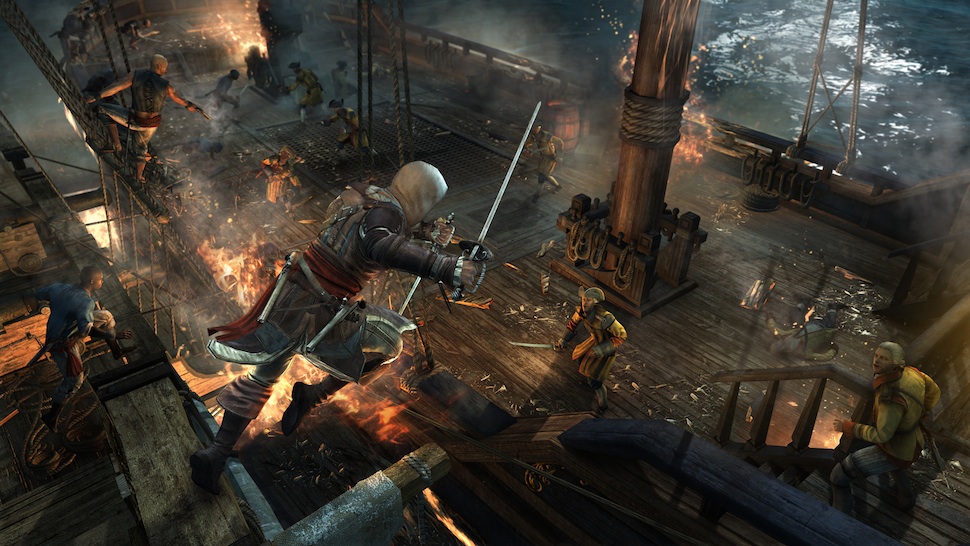
After you weaken an enemy ship, you’ll be given the opportunity to board. With the press of a button, the Jackdaw will lock in with the enemy. Your crew will throw grappling hooks to pull the two vessels together, creating a free-floating jungle-gym of sails, ropes and decks onto which spills a fracas of swashbuckling soldiers and pirates.
Ship-boardings are rarely less than terrific; they’re a remarkable feat of programming and a killer bit of video-game theatre. After locking in with the enemy ship, Edward can launch himself up into the Jackdaw‘s highest riggings, leaping across to the other vessel before diving from their crow’s nest onto their captain. Or, he can swing Tarzan-style on a rope, landing on the main deck with his pistols and swords at the ready. I raided dozens of ships in my time playing Black Flag, and I’ll raid a dozen more before I get tired of it.
An Assassin’s Creed game wouldn’t feel complete without sidequests and hidden activities, and Black Flag certainly meets whatever requirements the series dictates. In fact, it offers far more to do than is necessary. Among the generous offerings is a fleshed-out multiplayer suite, which I had a chance to try out for an hour and a half at Ubisoft’s San Francisco headquarters. I enjoyed my time with it — multiplayer matches generally play out like a deadly game of hide-and-seek, with some enjoyable co-op options added for the new game. That said, I don’t feel I’ve had enough time with multiplayer to factor it heavily into this review. If and when I’m able to spend more time with the multiplayer post-release, I’ll share more substantive thoughts. For now: It’s fun, but it’s not the main event.
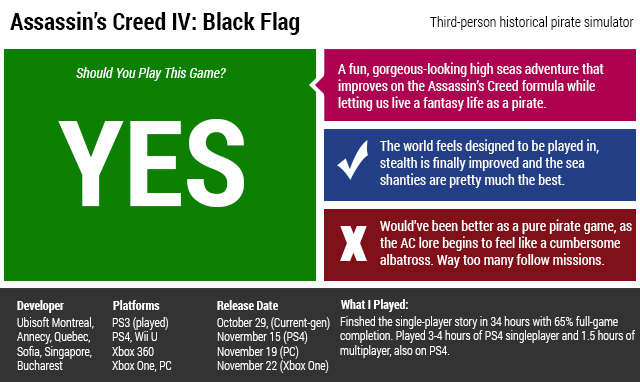
Over the past several years, Creed games’ singleplayer campaigns have swollen to Tetsuo Shima-like proportions, often becoming incoherent, lumbering collections of sidequests, crafting systems, minigames, social and mobile game tie-ins and unlockable extras. Thanks to a fair amount of clips, cuts and streamlining, Black Flag — a game I would never call “focused” — is still a more focused game than recent entries in the series.
The changes and deletions are almost entirely for the better, and there’s a newfound sense of pointfulness to a lot of the crafting and collectables that remain. You’ll hunt animals not only out of a desire to collect pelts, but because their bones and hides will allow Edward to craft better holsters and armour, increasing his offensive and defensive capabilities. Sea shanties replace almanac pages as the floating things you chase across rooftops, but they’re worth running down simply because the shanties themselves are so much fun to listen to.
Still, so much fat and gristle remains that the dedicated completionist will likely feel as overwhelmed by Black Flag as any previous game in the series. After finishing the story by logging 34 hours of singleplayer, my completion-counter sits at 65%. There are treasures I’ve yet to dig up, hidden islands I’ve yet to find, sunken wrecks I’ve yet to explore, legendary ships I’ve yet to battle, and upgrades I’ve yet to unlock. I could easily feed another dozen hours to this beast, and I doubt it would be sated.
Black Flag‘s system of tiered rewards and useful craftable items is as supremely seductive here as it was when it appeared in last year’s Far Cry 3. A year removed from that game, I’ve begun to question its diabolical effectiveness. Here I sit, playing a game until three in the morning, all because I need to get enough money to purchase a stronger rowboat. I need the stronger rowboat so that I can harpoon enough great white sharks to upgrade my armour, and I need to upgrade my armour so that I can take more damage when I try to board that Man of War. I need to board the Man of War so that I can get more metal, which I can use to reinforce my ship’s hull, so I can take on a fort…
Why on earth have I been doing this stuff? Was it intrinsically enjoyable, or was I simply hooked on the small rush of regularly accomplishing small goals?
Black Flag ceaselessly adorns itself with bonus objectives, social quests, and completion-percentages that would cross the eyes of even the most learned pirate. The Creed games seem addicted to UI clutter, on-screen text and icons that act as flesh-eating digital ants infesting an otherwise aesthetically wondrous game. “Score! Percentage! Status update!” these pop-ups announce, littering the screen with text, social readouts, reports, control mappings, contextual prompts, map icons, and all manner of other blinking bits and bobs. You can, thankfully, toggle the UI elements off, but the default setting often feels like the way the game was meant to be played.
Many a story mission ends with a quiet moment or dramatic revelation, only to have that moment cut agonizingly short by a charmless results screen. Edward’s friend has died and he’s about to set out on a quest for revenge, but just so you know, you didn’t shoot three crocodiles with sleeping darts during that last mission, and we really wish you had. And oh, while you’re here, would you like to rate this mission on a scale of one to five?
Every time I untangle myself from Black Flag‘s disconcertingly absorbing scaffold of rewards and challenges, I can’t help but question my motivations. Why on earth have I been doing this stuff? Was it intrinsically enjoyable, or was I simply hooked on the small rush of regularly accomplishing small goals? Why does the armour upgrade require shark bones? Didn’t I just make something similar with deer hide?
What am I doing here, exactly? Do I even care about Edward Kenway? Am I happily living the virtual life of an 18th century pirate, or am I trapped in a VR machine, running in place, endlessly chasing a digital horizon that never gets any closer?
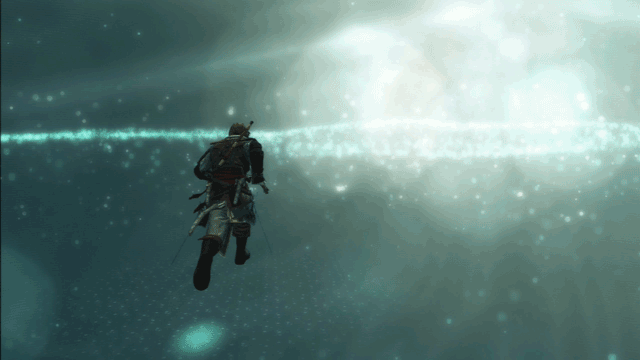
Frequently there are moments in Black Flag when I’m enjoying myself while simultaneously questioning why I’m enjoying myself.
As I explored present-day Abstergo Entertainment, I came across an email chain that had been circulating among the studio’s higher-ups. In it, they batted about possible settings for new games, a tantalising list that included thirteenth century Egypt, the French Revolution and even 1967’s Summer of Love.
Here were a half-dozen members of the fictional studio’s creative elite, openly musing about the new settings and characters they could focus on next. What sells, they asked. What do people want to play? Do they want to be soldiers, fighting alongside Joan of Arc? Or spies, assisting the uprising at the heart of the French Revolution?
As I read those fictional emails, I detected shadows of Ubisoft’s real-life struggle with this series. Is it time to simply dedicate these games to pure historical adventure-tourism? Must they perpetuate an ever-more-convoluted tale of techno-adventure and epoch-spanning global conspiracy? Must each game’s fiction be connected to the one before it, or would players just as happily sign up for a different self-contained adventure each year — this year Edward the pirate, next year a samurai, the year after that a 1950s detective? If the Assassin/Templar stuff were removed from the series altogether, would most players really miss it?
Black Flag often feels like two games: One, a pirate game in which you can ram your ship into an enemy brig before leaping onto their decks. The other, a bog-standard Assassin’s Creed game, in which you follow guys on the street, decipher a novel’s worth of lore and backstory, and leap off of buildings into piles of hay. The first game feels exciting, fresh and at times sensationally fun. The second game feels increasingly tired.
Like many of the characters who populate its world, Black Flag seems keen to slough off the vestiges of its ancestry and fly free. It is a significant improvement for the Assassin’s Creed series, a gorgeous piece of digital entertainment that makes good on its outsized ambition with remarkable regularity. And yet here I am, still locked in that metaphorical loading screen, running forward while wondering if I’m getting anywhere at all.
At least this time I’m dressed as a pirate. For now, that’s enough.
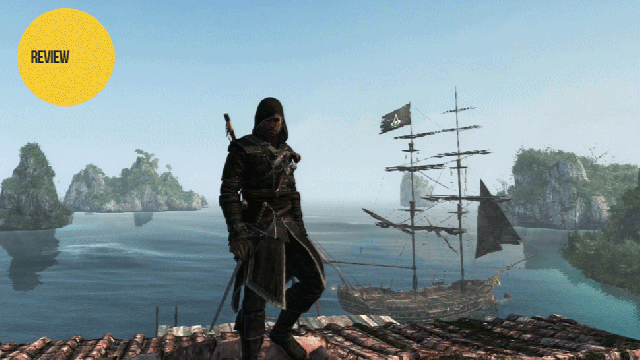
Comments
9 responses to “Assassin’s Creed IV: Black Flag: The Kotaku Review”
The game starts by throwing us into Kenway’s boots as he pilots an ill-fated pirating vessel before, in short order, setting him up to kill a treacherous member of the West Indies Chapter of the Assassin’s Guild, Local 104.HOLY SHIT KIRK…. WAY TO GO with the spoilers dude. I mean I’ve already played this part, but thats a pretty BIG part of the plot to begin with mate. There was ZERO reason to give that away. I know this is an American article but can someone change the title or something or ut spoiler tags in the title? Not every review actually contains spoilers, the best reviews are usually spoiler free?
I think this is a great review personally. Also, I have never accidently read a spoiler…..
It is a great review, and sorry to disagree with you but you do indeed read a spoiler, and a fairly hefty one, before you realise it. You don’t *actually* have ESP when it comes to spoilers, that’s why people usually put up ‘spoiler’ tags and such.
I would actually prefer it if reviews covered the entire story. That way, all those who come and rage at review scores, reviewers etc. (not you, your point is valid), will instead not read the review, knowing it will be packed with story spoilers. Causing them to play the game, even if it “ONLY GOT AN 8 OUT OF 10!!!”
That’s the first review i’ve read to completion in over a decade, nice one.
I still think the best thing to do would be to simply have said assassins creed 3, Connor and desmand live happily ever after the end. Then this year released Super happy pirate adventures with climby the pirate (working title) and start a whole new thing they could milk for half a decade.
Have to agree. This could have been completely AC unrelated and been an amazing game in its own right.
I ‘really’ do not want to spoil the experience of AC4 before the Next-Gen comes out…….but damn does this review make it tempting 🙂
Day one PS4. Hype I guess? Sure why not. HYPE! :p